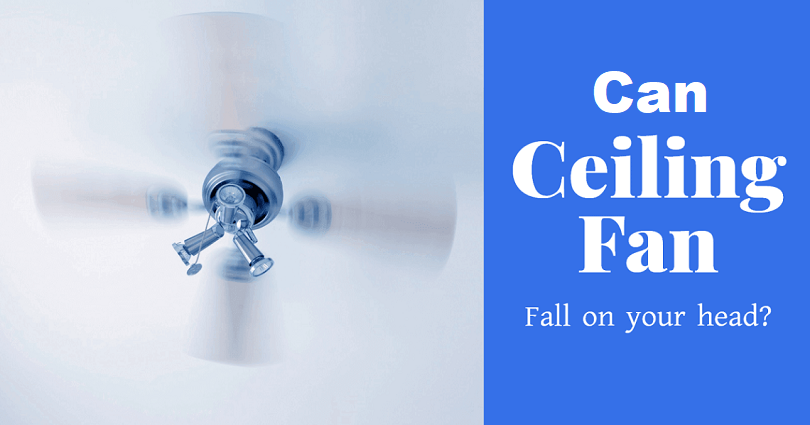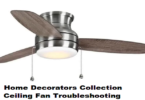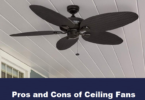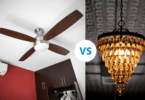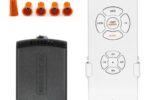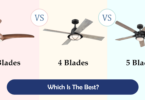A beautiful ceiling fan unit that is installed on your ceiling can fall down on your head at any time, and chances are it can kill you, is it true? We are going to find out about it in this post. Go through the post to be safe.
Have you avoided going to bed thinking if the ceiling fan in your room can fall and injure you or any of your family members?
There are a lot of rumors are going on about whether ceiling fans can fall. A lot of people are afraid of their ceiling fans while lying down on their beds that they may fall on them while sleeping and crushing their heads, and restricting them from waking up again.
The government of South Korea decided to reduce the energy consumption of houses during the energy crisis in 1970s. So they started propaganda that claimed “fan death” were in full swing. This claim was based on an article in 1927 about how electric fans caused harm. In this modern age, most people have the same attitude for ceiling fans.
So, the questions arise, can ceiling fans fall and harm you? What are the chances of a fan injuring you?
In this article, we are going to analyze the safety of a ceiling fan. Moreover, we are going to give you an actionable and comprehensive guide on how to stay safe.
Before getting started, you need to understand how a ceiling fan works.
Contents
Parts of a ceiling fan and their injury potential
You need to focus on the components of a ceiling fan in order to under the safety of using it. The functionality of its parts can result in any defect of the fan. Below are the main parts of a ceiling fan.
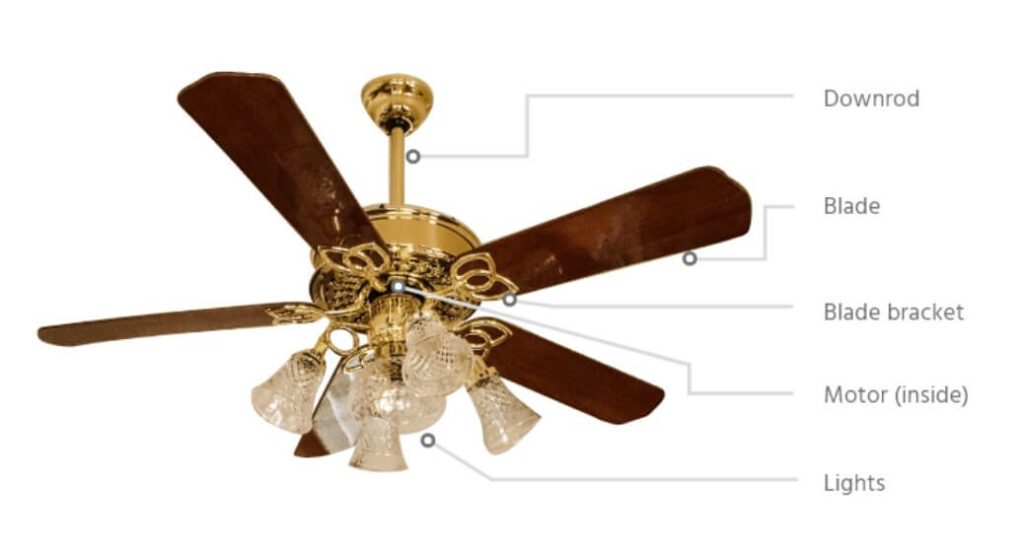
Down rod
The down rod is a metallic, wooden or plastic bar that allows ceiling fans to hang down from high ceilings. The rod is very important in terms of the safety of a fan. The strength of the downrod will prevent it from falling.
Electric Motor
The motor is another crucial part of a fan. It supplies electricity and converts it into motion. In a nutshell, electric current flow through the motor and as a result, it makes mechanical energy. The motor is behind the rotation of the blades.
It is worth mentioning that the motor is the heaviest component of the fan. Most of the time, it is metallic and the size is different with the application of the fan.
The Blade Brackets
The blade brackets help the blades to connect to the motor and are usually made of metal.
The blades
Standard ceiling fans are designed with two to six blades. Heavy and sized to precision, and are designed from plastic, metal or wood. Usually, weighty models contain fewer blades as compared to lighter fans. For example, large industrial brands contain two or three blades whereas home ceiling fans contain four to six blades.
Lights
Modern fans are designed with lighting fixtures. The fixtures are either found above, inside or below the motor. The bulbs also run on electricity similar to motor, and are usually changeable.
Common fan defects
A fan is the same as other appliances and is more likely to get defective now and then. The problems of the fan can start from the screws, fan parts or its surrounding. If the screws are not tight appropriately, the fan will get imbalanced and wobble.
Unchecked electric current can result in damage to the inner parts of the fan. As a result, ceiling fan will malfunction. When the electronic system of the fan is spoiled, it can make the unit useless.
The surrounding of the ceiling fan can also affect its function. For example, if the material is unstable in which the fan is mounted, the unit may wobble. If the unit is near to the floor or hanging low, it might be troubled by the lamps, furniture or other appliances. A low placed fan may even shave your head in severe circumstances.
Wobbling
When the fan blades are not balanced, there is a great chance that they will wobble. The imbalance may be present when the weight of one blade is heavier than the other.
Or, when the distance between the blades is not equal, the fan may slope towards one side. This can also result in annoying noise.
If the fan is not seated in a proper way, or the screws are loose, wobbling can lead the fan to fall. However, there are very low chances that a wobbling fan will fall.
Faulty motor
At times, electric current may burn out the main parts of your fan. The motor is a crucial and vital part of the unit. As we have mentioned earlier, a motor is a part and parcel of the fan as it moves the blades. If a motor is burnt out, you should get a replacement. Usually, the motors of the fan are expensive, and it is a wise decision to change the whole unit instead of repairing or getting a new motor.
Fan falls
A fan comes down when a part or the whole fan responds to gravity. The falling of fans is not frequent. In the last decade, few fan falls have been recorded. The fans would not fall by themselves. The collapse will happen because of damaged ceilings, rotten wood or improper installation.
Fact checking: Can Ceiling fans fall and kill you?
How safe are ceiling fans, and can they fall? These are the common questions that only experts can answer and that is why we are writing this to explain about it. we need to check four main problems:
- how hard or easy it is for a fan to fall?
- how much force a standard ceiling fan applies on the ground if it works on free fall?
- How much weight is required to crush a human’s skill?
Keeping in view the findings above, we can find out easily if a ceiling fan can fall and kill an adult human. So, let’s go through the stats.
The possibility of a fan falling
The straightforward answer to this question can be 50%, mathematically. However, keeping in view this, there are only two options, to fall or not to fall. But, the possibility of a spinning ceiling fan dropping is based on different factors. The factors are the rotations of the motor per minute, the mass of the blades, the weight of the fan, and gravitational pull among others.
Furthermore, the downrod and the mounting bracket have to be strong enough to firmly hold the fan weight.
A general principle, however, is that the chances of falling off your ceiling fan are negligible as far as no external factors are involved in the fan.
Numbers of people decapitated by a ceiling fan
The stats of deaths or injuries done by fan falls every year are not known. In short, there is hardly anything to record.
The maximum force exerted by a falling fan
The normal ceiling fan contains a mass of more or less 15-35 pounds up to 15 kgs. If it is mounted 8 ft above the ground, the unit will exert a force of about 65-150 newton. A standing person will not be killed but will be hurt a little.
Amount of force required to crack a human skull
This detail may be surprising to you, but do you have any idea that a human skull is stronger than steel? Yes, it is true.
According to experts, “the thinnest region of the skull bone is about two centimeters above and in front of the top of your ears. Sort of where your temples are. To fracture the skull there would require 500 kg, or the force that 500 kilograms (1,100 pounds) would exert in standard gravity.” Quote from Washington Post.
So, after reading it, you will be able to know that the force exerted by a free falling ceiling fan is not strong enough to decapitate a human.
Fact-checking conclusion
It rarely happens that fan falls. There is hardly any stats to prove the number of casualties caused by ceiling fans. domestic ceiling fans falling from the normal ceiling do not exert enough force to kill a healthy adult.
In fact, a research in Kuala Lumpur, the head injuries caused by fan accidents can be fatal, but they are a result of “ignorance and negligence.”
How to prevent a ceiling fan from falling
If fan-related incidents hardly happen, it does not give you the authority not to take precautions. If you are afraid that your fan will fall, here is what you need to do in order to save yourself.
Fix height issues and fan clearance
The main factor is the height of the room when it comes to avoiding accidents happening from ceiling fans. if the units will remain close to the floor will get in contact with humans or other objects.
These factors can swing the fan, hit it or even deteriorate it. The mechanical damage or fan falling can be prevented by fixing the clearance and height issues.
The average height of a human adult is about 5.9 ft tall. Therefore, the unit should be higher than this height. The ideal way is to install a ceiling fan at least 8-10 feet from the floor. It will enable tall adults to go into rooms easily and freely.
Once again, it is essential to have enough clearance for the fan. The blades of the fan must be away from the wall. The perfect will be at least 18 inches from the wall.
Tighten screws
Loose screws are also one of the main causes that can result in fan fall. As we have discussed earlier, there are hardly any chances of fan falling. However, you should tighten screws whenever you see wobbling. During the installation, you should tighten them but it is also necessary to ensure they are always close-fitting.
It is very simple to tighten the screws that only needs a screwdriver. There are no special skills required to fix the screws of your fan. first of all, turn off the fan and hold it tightly when you start inspecting or working on the screws. Turn off the electric power to make sure the fan does not switch on even by accident or mistake if someone does it.
After cleaning the fan if it needs cleaning, inspect and tighten all the visible screws. Usually, there are a lot of screws that connect it to its different parts and they are also visible. It is enough to hand-tighten them. but when it comes to dealing with a large industrial fan, you should use an electric screwdriver. Now, turn on the fan and make sure that the problem is fixed.
Regular maintenance
The question is how often do you do maintenance of your unit? It is necessary to check your fans after six months to make sure your safety.
The process also helps you to find out any abnormalities related to your fan as soon as they begin to show. This way, you will be able to find and fix those issues before any fatal accident.
In addition, regular maintenance is also necessary for the fans and it ensures their longevity.
Here are a few tips on how to do maintenance of your ceiling fan.
Cleaning, lubricating, tightening screws and straightening blades are some of the maintenance practices that ensure your safety as well as the longevity of the fan.
You must clean your fan twice a year. For this purpose, you can use a ladder or stool. Remove the sticky stains with the help of a soapy dank cloth and brush its blades. To get rid of the dust, vacuum out the motor. You can also prevent rusting by cleaning it.
If you do not use a fan 24 hours a day, it is ideal to lubricate your fan every two months. Fill the oil hole until it flows out and use a cotton cloth to wipe the additional oil. When you oil your fan, the movable components of the fan remain functional for a long time. It also avoids the wearing out of the crucial parts.
Apart from that, also inspect the mechanics of the fan biannually. Firstly, you have to tighten all the loose screws which we have already discussed above. After doing so, ensure that your fan blades are not imbalanced. You can do it by using a fan balancing kit. A balanced fan does not wobble unless you have another issue with it.
You need to focus on another important factor when you are doing ceiling fan maintenance that is, its direction. Modern ceiling fans are available with the reverse direction feature. It means that your fan must have a switch on it, if you flip it, the fan will turn the anti-clockwise or in the opposite direction.
Although the aim of the fan is not to cool or heat up the air in the room, they only give rise to the diffusion of temperature. The blades of the fan generate air around the room when they move. The air and heat will be distributed throughout the house due to the direction of the fan’s blade rotation. Therefore, when a fan moves the wrong way will result in a reverse effect of what you are expecting from it.
According to experts, you need to turn your fans counterclockwise in the summer months and clockwise in the season of winter.
Call certified professionals to install the fans
Although it may sound easy to you when it comes to mounting fans, in reality, it is a sophisticated work. The length and weight of the blades should be inspected along with the motor speed. These factors help you to find out the momentum or force that the blade exerts on the blades. Ensure whether the fan is safe or not depends on the blades’ momentum and their construction’s capability to hold it. In a nutshell, if not installed properly, a ceiling fan can fall.
You may have to spend a few dollars to hire the experienced and professionals to install a ceiling fan but the process will keep you safe. The reason behind it is that they are qualified for it and trained specifically for it. You need to find an interior installation agency or a fan company for this task. This type of company will do the proper installation and give you a warranty too.
In a nutshell, hire a professional to get the job done (install the fan), they are not only skillful but also accountable for the job they have done.
Choose the right fan
Every ceiling fan that attracts your attention is not perfect for you. Ceiling fan’s efficiency depends on the features designed for the environment. For example, if you have a office or house in a wet or moist area, you need to get the units that are suitable for such conditions. usually, a damp environment can result in the fan rust. This can reduce the life of your fan.
There is no doubt in saying that all fans are not rated for outdoors. Heat, humidity, and UV light and rust often damage the fans. you need to get a fan rated as “WET”, if you are looking for a fan for bathroom or outdoor use. This type of fan comes with sealed motors, designed with non-rust material like stainless steel and UV-resistant blades.
In addition, you need to make sure you are buying a high-quality fan. it is the best if you choose a fan from a company that offers warranted models. Just keep in mind that you can also sue a fan manufacturer or installation firm for injuries related to fan.
Final Words
It can be normal to think that a ceiling fan will fall and kill you in your sleep. However, the feeling is similar if you think that your desktop monitor will blow up on your face any day, if you have done all the things to avoid accidental falls including proper installation by a certified person and regular maintenance etc.
In short: this feeling comes due to a psychological anxiety known as Aanemistiraphobia. This psychological condition is the fear of fans or simply you can say fan-phobia.
By now, we are confident that you know if a ceiling fan can fall and hurt you. There are hardly any chances of ceiling fan falling keeping in view the reliable scientific studies, the chances are there but they are negligible. Therefore, you do not have to be worried.
To prevent it, the safety measure you can take is to ensure that you buy a top quality fan and call a certified professional to do the installation. After that, do the maintenance on a regular basis. Fix the wobbling whenever you observe it.
What’s Next
How To Measure Ceiling Fan Size: Know These Tips Before Buying
Are Ceiling Fans Outdated? Here Are 11 Reasons To Still Consider Them

